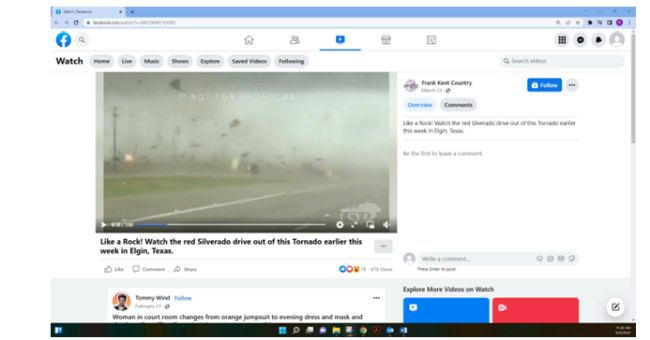Businesses looking to capitalize on amusing or interesting videos in social media channels should beware of potential copyright infringement liability and bear in mind that a fair use defense may not be available. When a Texas Chevrolet dealership, Frank Kent Country, LLC ("Frank Kent"), modified an individual's copyrighted video (including by adding new audio and captions) and published it on social media, a commercial licensing entity, Viral DRM, LLC ("Viral"), which had acquired the video and accrued causes of action for infringement, sued the dealership. Frank Kent moved to dismiss the action, but the U.S. District Court for the Northern District of Texas denied the motion, holding that Viral had standing to sue, and rejecting Frank Kent's fair use defense because the modified video replaced Viral's market and undermined Viral's business.
Factual and Procedural Background
In March 2022, videographer Ronald Emfinger created an original video depicting a red Chevrolet Silverado pickup truck driving through a high-intensity tornado. Chevy dealer Frank Kent downloaded the video from the Internet, added audio from a Chevrolet advertisement and a caption reading "Like a Rock! Watch the red Silverado drive out of this Tornado earlier this week in Elgin, Texas," and posted the modified video to its Facebook page.

Exhibit 2 to the First Amended Complaint (March 24, 2023)
Shortly thereafter, Emfinger assigned his copyright in the video to Michael Brandon Clement and Brett Adair. Clement and Adair registered the copyright in April 2022. In May 2022, Clement and Adair assigned the copyright and any causes of action for infringement of it to Viral, which is engaged in the business of commercial licensing of videos to online and print media.
In February 2023, Viral sued Frank Kent for infringing its copyright in the video. Frank Kent moved to dismiss, claiming that Viral lacked standing and that the dealership's use of the video was protected as fair use. On August 16, 2023, the U.S. District Court for the Northern District of Texas denied the motion on both grounds.
Viral Has Standing to Sue for Copyright Infringement
Frank Kent claimed that Viral lacked standing to bring the infringement action because Viral was not the owner of the copyright in the video. However, the court noted that a copyright owner may assign the copyright and all accrued causes of action for copyright infringement if the underlying contract "contains language explicitly transferring causes of action for prior infringements" (citing Hacienda Recs., L.P. v. Ramos, 718 Fed. Appx. 223, 233 (5th Cir. 2018)). Viral adequately pleaded that Clement and Adair assigned to it the copyright to the video, in addition to "any causes of action for infringements of the Video." The court, construing the facts in the light most favorable to Viral, found that the allegation was sufficient to plead transfer of the prior owner's cause of action for Frank Kent's infringement.
Viral Alleged Sufficient Facts to Overcome a Fair Use Defense
In evaluating Frank Kent's fair use defense, the court analyzed the four statutory fair use factors. The court noted that the first factor – purpose and character of the use – concerns "whether the user stands to profit from exploitation of the copyrighted material without paying the customary price," "whether use user acted in good faith," and "whether the use is 'transformative,' meaning it 'adds something new' to the copyrighted work" (citing Harper & Row Publishers, Inc. v. Nation Enters., 471 U.S. 539, 562 (1985); Bell v. Eagle Mountain Saginaw Indep. Sch. Dist., 27 F.4th 313, 322 (5th Cir. 2022)). Viral alleged that Frank Kent, a car dealership that sells Chevrolet vehicles, "stands to profit from exploitation" of the video. The modified video contained the copyrighted video containing a Chevrolet Silverado, and Frank Kent added to it an audio clip from a Chevrolet advertisement and a caption quoting a Chevrolet tag line ( "Like a Rock!"). Frank Kent argued that its use of the video was "purely parody" or "news reporting," but even if Frank Kent's use had a mixed purpose, the court held that the mixed purpose "does not undermine the commercial nature of the Facebook post." The court held that this factor weighed in favor of Viral.
The second fair use factor – the nature of the copyrighted work – is, the court observed, "widely considered the least significant fair use factor" (citing Bell, 27 F.4th at 323). Among other considerations, the second factor supports a finding of fair use where the work is factual (as compared to fictional), and where a work is widely disseminated (as compared to privately disseminated or unpublished). Here, the video provided a "factual portrayal of a real event" and was "published and widely disseminated on the Internet," and the court therefore held that the second fair use factor "weighs in favor of a finding of fair use."
The third factor – whether the amount taken by the defendant is quantitatively or qualitatively significant – weighed strongly against a finding of fair use. The court found that Frank Kent used the entirety of the video and, moreover, the "heart" of the video (citing Bell, 27 F.4th at 324).
Finally, the court noted that "undoubtedly the single most important element of fair use" (citing Harper & Row, 471 U.S. at 566) is the fourth factor, i.e., "the effect of the use on the market for and value of the copyrighted work" (citing Bell, 27 F.4th at 324). Viral is an entity "created for the purpose of licensing videos to third parties for commercial use," and "its business model relies on the payment of licensing fees by entities like Frank Kent to use videos that Viral owns." Frank Kent's unauthorized use "would undermine Viral's licensing scheme" because "[t]he ease with which others could similarly reproduce the Video and include a caption alluding to the quality of Chevrolet vehicles . . . harms the market for the Video." The court added that "the mere fact that the Video has been disseminated widely on social media does not undermine this conclusion."
Reading all facts in the light most favorable to Viral, as the party opposing the motion, the court held that the balance of the fair use factors weighed against a finding of fair use (i.e., in Viral's favor) and denied Frank Kent's motion to dismiss on this basis.
Although the court did not once cite to the U.S. Supreme Court's May 2023 decision in Andy Warhol Foundation for the Visual Arts, Inc. v. Goldsmith, the parallels to the licensing and market replacement analyses in the Viral DRM decision are notable. Read more about the Warhol case in our article SCOTUS: Fair Use Defense Fails to Protect Warhol's Licensing of Orange Prince.
The case is Viral DRM v. Frank Kent Country, LLC, No. 23-cv-0250-D, 2023 WL 5284844 (N.D. Tex. Aug. 16, 2023).
The content of this article is intended to provide a general guide to the subject matter. Specialist advice should be sought about your specific circumstances.


